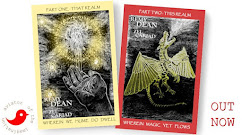Andrew Jenkin is a professional artist, illustrator and author. His pictures have been exhibited internationally, and in 2012 he was was shortlisted for Artist of the Year, by Artist & Illustrators magazine.
The first book that he has both written and illustrated was The Curse of the Lambton Worm, about dragon folklore in the North-East of England. An exhibition of the original illustrations from the book toured venues in the North-East and he was invited by the Akron Fossils & Science Centre in Cleveland, Ohio, to exhibit his illustrations and research from the book. He has also illustrated two books about Honley, the West Yorkshire village where he grew up, and has recently illustrated Tapestry, a children’s fairy-tale written by Richard King. His latest book, The Legends and History of Castle Hill, Huddersfield, also deals with the folklore and history of a particular place.
Andrew is also enthusiastic about teaching art and hosts regular watercolour classes in North Wales, and monthly workshops in West Yorkshire. Before moving to Wales in 2010, he was Head Tutor and Studio Manager at North Light Gallery Art School in Huddersfield.
Andrew talked to Remy Dean about words and pictures, curses and Camelot...
 |
| Andrew Jenkin, author and artist |
I attended a series of workshops with a government-funded organisation called CIDA (Creative Industries Development Agency – I don’t think they exist anymore). They were really enthusiastic about artists getting their work into galleries, and gave me a ‘just do it’ mentality.
I had previously worked with an art gallery in Washington (near Sunderland) which was situated yards from where the events of the legend of the Lambton Worm were supposed to have taken place. It was a legend I had known since childhood, so I enjoyed researching its background. An exhibition of my illustrations connected with the legend was given the green light, and this in turn led to the book.
 |
| The Curse of the Lambton Worm by Andrew Jenkin |
The new book, The Legends & History of Castle Hill, Huddersfield, explores the stories which surround an old hillfort near Huddersfield, West Yorkshire, which is where I grew up.
It is similar to the Lambton Worm book in that it seeks to find some truth or explanation for some very strange legends – in other words, how did these stories start? It draws on literature, landscape features and history to piece together the puzzles and provide an explanation.
It is different because it goes through almost every era, right back to the Neolithic, and is a hotchpotch of different legends. The Lambton Worm book was connected to landscape features, such as Worm Hill and Lambton Castle, but concentrated on only one legend - probably medieval.
You’re a professional artist and provide illustrations for your books – what, if any, are the links between these two creative formats – the visual and the textual?
I usually have an overall idea for the illustrations, or perhaps one really striking image, which will help with the tone and mood of the text.
I always have to get the text right first, because I work mainly in watercolours, so once I’m committed to an image, there’s no changing it and no going back!
Illustrating in watercolour is completely the opposite to writing, which benefits from revision and refinement – if a watercolour is re-worked or altered, it loses its original vitality, so you only get one chance with the paint.
Do you find that the artist’s eye and way of looking helps to capture a sense of place in writing?
As an artist, I probably think too logically about the image in front of me, or the image in my head if it’s an illustration – what is the composition, where are the lights and darks, what are the colours?
As a writer, I would be thinking much more about atmosphere and mood before putting pen to paper. Having said that, most of my writing is fairly factual, so the logic starts to filter back in once I’ve started.
What is your writing process like?
I usually work out a rough outline first, then every few days I scribble something onto a scrap of paper, Once the pile of scraps is big enough, it all gets transferred onto my computer, and the hard work commences - a slow process of building the text, then going through draft after draft until it’s right. Some sentences come straight away, but some can be re-written a dozen times before I’m happy with it.
What time of day suits you best?
Evening work suits me best, mainly due to daytime commitments, but also I find that the later it gets, the more ‘free’ my thinking and writing becomes.
What is it about the subjects of your books that interested and inspired you to write about them?
I have always been interested in history and legends; I have a degree in History and Ancient History, and I suppose I’m still studying.
There is a pub near Sunderland called the Lambton Worm, which I visited as a boy. I was fascinated by the pub-sign, which depicted a knight clad in spiked armour, with a serpent-dragon coiled around him. I am still fascinated by it.
I grew up in one of the villages beneath Castle Hill, so I saw it every day for the best part of twenty years. I remember reading an old Council pamphlet about the legends, which seemed oddly out-of-place in an industrial town in West Yorkshire, and really sparked my interest. The new book is my own version of that pamphlet.
I guess it’s the idea that there is much more to life than what we see around us, we are surrounded by the spirit of our ancestors and our own imaginations – it’s not just a hill, it’s the hill where such-and-such happened. It makes life much more interesting!
 |
| Colourful Camelot illustration for Andrew Jenkin's new book |
I am aiming to write books for my ten-year-old self – the boy who was fascinated by the Lambton Worm pub-sign, and who read the Castle Hill pamphlet in disbelief.
However dry the history, and, on occasions, cynical the explanations, I would always be very careful not to kill the original excitement and weirdness of the legends.
Do you have a favourite book of all time, or one that you have re-read or return to often?
In my mid-twenties I read Handbook for the Urban Warrior by Barefoot Doctor (aka Stephen Russell), and it completely changed my whole outlook on life. The book is a very modern and accessible introduction to ancient Eastern mysticism and Taoism. I re-read this book, and others by the same author, on a regular basis, and always refer back to them when I have any kind of problem.
Who have been your favourite authors and artists – what have you learned from them?
Favourite artists would definitely include the Pre-Raphaelites, from the painstakingly detailed technical side of what they were doing - although I wouldn’t have the patience! ...and also for their subject matter. I also love the pen-and-ink illustrations of Arthur Rackham, again for technical brilliance and subject matter.
These artists took years perfecting their art, and their high levels of skill and craftsmanship shine through the work.
I don’t have one particular favourite author, but would probably choose an ‘old classic’ over a contemporary writer - apologies to all contemporary writers!
I’m still stumbling through The Mabinogion, which I’ve been reading on-and-off for several years now (since moving to Wales in 2010 in fact!) and still have a long way to go. I love legends, but these are a bit heavy!
If you could time-travel, what historic personage would you like to meet and what question would you ask them?
It would have to be King Arthur, or whoever was most closely linked with this half-historical, half-legendary figure.
I’m not sure exactly what I’d say to him - “Do you exist?” - but that’s a period of history which I would love to learn more about. Unfortunately we probably never will, because for those two hundred years, circa 400-600 AD, everybody was too busy fighting or fleeing to write anything down.
Archaeological evidence is helping to provide some clues, and it may be that some future as-yet-uninvented method of investigation brings more answers…
If he’s ruled out as a fictional character, then I’ll go for a round table discussion - sorry - with Ambrosius Aurelianus, Vortigern, Hengist and Horsa.
I would like to sit in on that!
Thank you, Andrew.
Andrew Jenkin was talking with Remy Dean
For more about the art of Andrew Jenkin,
check out his company website Arjent Design
...and here is more about The Lambton Worm book





